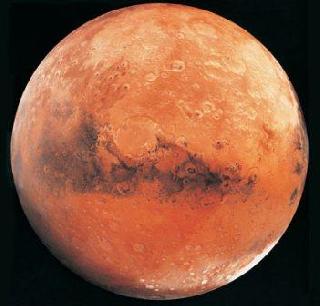
LONDON (PTI): Scientists have found evidence that suggest Mars had once earth-like conditions for at least a few hours a day, a finding they say makes it more plausible that the planet could have supported life billions of years ago.
The pioneering research, which analysed the minerals in a four billion-year-old Martian meteorite, provided the first strong evidence that Mars used to be warmer and wetter than it is now.
The minerals seem to have formed at around 18 degrees Celsius, which suggests the planet could have supported life, although it's still a mystery whether the warm temperatures were only temporary, the Daily Mail reported.
"The thing that's really cool is that 18 degrees is not particularly cold nor particularly hot," said Woody Fischer, a scientist at the California Institute of Technology (Caltech) and co-author of the paper. "It's a remarkable result," he said in a release.
According to scientists, knowing the temperature of Mars is crucial to understanding the planet's history -- its past climate, and whether it once had liquid water.
The Mars rovers and orbiting spacecraft have found ancient deltas, rivers, lakebeds, and mineral deposits, suggesting that water did indeed flow.
Because Mars now has an average temperature of -63C, the existence of liquid water in the past means that the climate was much warmer then but what's been lacking is data that directly points to such a history, the researchers said.
"There are all these ideas that have been developed about a warmer, wetter early Mars," Fischer said. "But there is precious little data that actually bears on it."
John Eiler, another author of the research, said, "its proof that early in the history of Mars, at least one place on the planet was capable of keeping an Earth-like climate for at least a few hours to a few days.'
To make their measurement, the researchers analysed one of the oldest known rocks in the world: ALH84001, a Martian meteorite discovered in 1984 in the Allan Hills of Antarctica.
The meteorite probably started out tens of metres below the Martian surface and was blown off when another meteorite struck the area, blasting the piece of Mars toward Earth.
The potato-shaped rock made headlines in 1996 when scientists discovered tiny globules in it that looked like fossilised bacteria.
But the claim that it was extraterrestrial life didn't hold up upon closer scrutiny. The origin of the globules, which contain carbonate minerals, remained a mystery.
Suggestions about their origin depend on what temperature they formed at, with previous suggestions ranging from below freezing to 700c.
Finding the temperature through independent means would therefore help narrow down just how the carbonate might have been formed, the researchers added.
 Previous Article
Previous Article Next Article
Next Article












The Indian Air Force, in its flight trials evaluation report submitted before the Defence Ministry l..
view articleAn insight into the Medium Multi-Role Combat Aircraft competition...
view articleSky enthusiasts can now spot the International Space Station (ISS) commanded by Indian-American astr..
view article